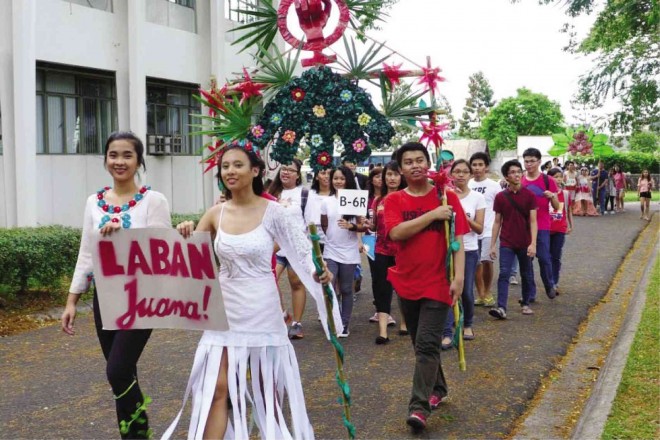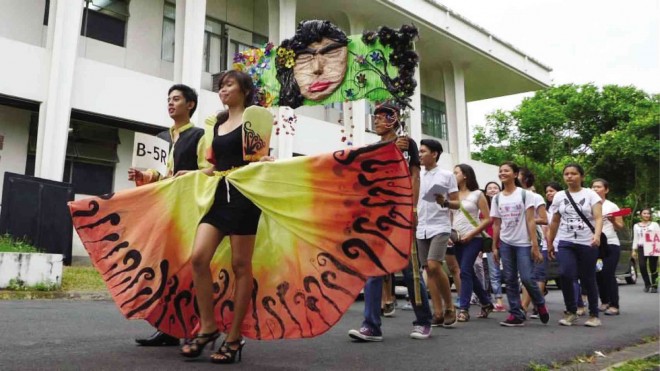A different ‘Flores de Mayo’ in Makiling

GENDER EQUALITY. A humanities class brings to fore equal gender rights by assigning two women as “escort and muse” to lead them in the “Flores de Mayo” at the University of the Philippines Los Baños in Laguna province. FLORANTE CRUZ/CONTRIBUTOR
Garbed in colorful costumes adorned with anything but “natural,” humanities students at the University of the Philippines Los Baños (UPLB) in Laguna province offered a fresh take on the traditional “Flores de Mayo.”
For the first time, the flower parade was held on campus on May 4 after the university implemented its new academic calendar (August to May) covering the summer months. The old calendar ran from June to March.
By tradition, Flores de Mayo (Flowers of May) is widely observed in the Philippines as a religious ritual in honor of the Virgin Mary. But UPLB humanities professor and activity organizer Toto dela Cruz said the parade did not only serve as an academic requirement but was in observance of the Philippines’ Natural Heritage Month as well.
Since 2003, the country has been celebrating Natural Heritage Month as part of efforts to preserve Philippine cultural heritage and strengthen national identity.
Makiling bloom
Some 1,000 students from 36 humanities classes joined the parade on a warm summer afternoon, starting at UPLB’s famous acacia tree, also known as the “fertility tree” as its thick canopy is said to attract amorous couples.
An escort and a muse, with a bamboo arc in tow, separated one class from the other in a long line of students that snaked outside dormitories and buildings. They wore costumes made from papier-mâché, straw, or paper cups that resembled only flowers endemic to the Mt. Makiling forest reserve, such as the Rafflesia and Hoya.
Toward the end, the parade stopped over the iconic “Mariang Banga,” one of the many statues of Maria Makiling holding a clay jar. Legend has it that Maria Makiling is the forest muse guarding the mountain.
Nothing religious
“There, (students) paid courtesy (to Maria Makiling) by saying, ‘Here we are and thank you,’” Dela Cruz said.
While Flores de Mayo is widely known in the Philippines as a religious procession, UPLB’s version, devoid of Marian symbols and prayers, was nothing religious. Instead, it was an attempt to “trace back the parade’s original form,” according to Dela Cruz.
Indigenous communities way before the Spanish occupation celebrated the “secular” parade in honor of nature and the bounty of flowers, he pointed out. In UPLB’s case, what better way to honor nature but to pay homage to the majestic Mt. Makiling which serves both as a scenic backdrop to the campus and an actual laboratory for the study of ecology.
Dela Cruz said the idea of the sagala (traditionally known as a beauty pageant or parade) is the appreciation and preservation of both natural and cultural heritage.

Students honor nature as they promote natural and cultural heritage through a flower parade on May 4 at the University of the Philippines in Los Baños, Laguna. FLORANTE CRUZ/CONTRIBUTOR
Social issues
“It was a two-pronged advocacy. One is to look into and see the beauty of the natural heritage, and two, to look into the issues (concerning) our rich cultural heritage that we are slowly losing,” he said in a phone interview last week.
They aim to put together nature, arts and science into a single “community experience” but without missing out on the so-called “tatak UP” as being socially relevant.
Some of the classes went further in touching social issues, such as gender equality, by assigning two females (instead of a male escort and a female muse) to lead their class.
One class dressed up the escort in a soldier’s uniform, with an arc in tow that resembled the number 44 in memory of the 44 Special Action Force members slain in the Jan. 25 Mamasapano, Maguindanao, encounter. Another called for the protection of Filipino journalists by carrying tags that read the names of slain journalists.
UPLB’s Flores de Mayo was just one component of a three-year “Agri-Kultura” program of the university through its Office for Initiatives in Culture and the Arts, which promotes the relationship between science and culture through a series of exhibits and arts activities.
In the years to come, Dela Cruz said he wished for UPLB, known more for being a science and agricultural institution, “to become a mecca for young people and talents” whose creativity goes beyond the bounds of an academe.